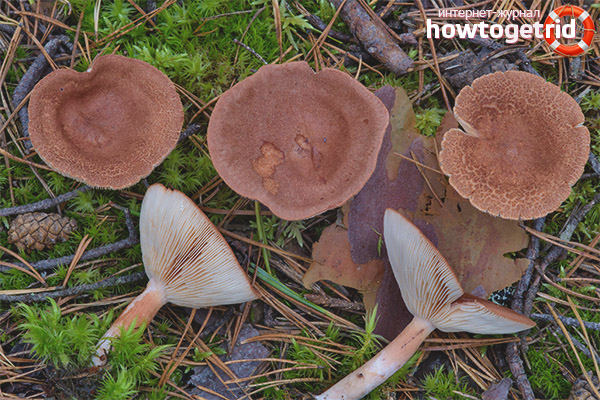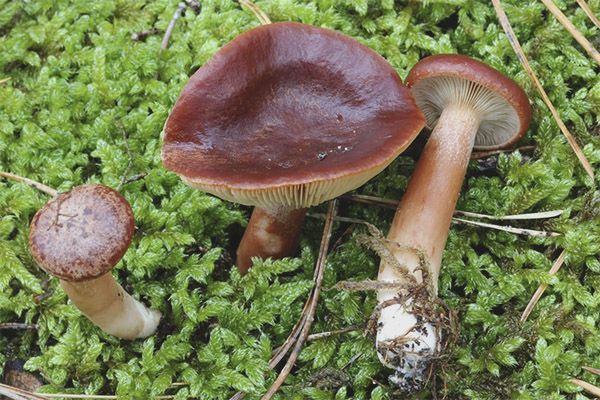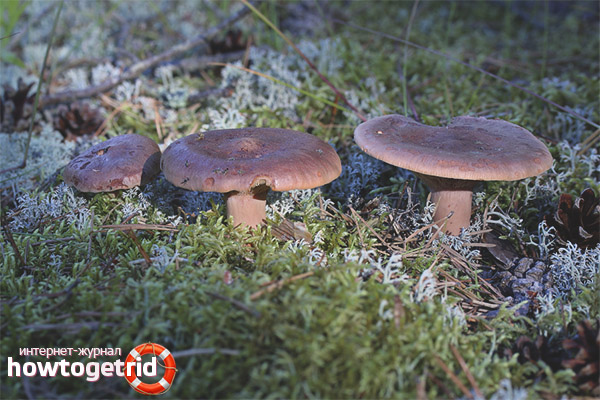The content of the article
Bitter is a fairly well-known and common mushroom. This name he received for the taste, which he has somewhat pungent and pungent. Therefore, not all mushroom pickers are ready to put the mushroom in their little basket. In Western countries it is not considered edible. In some sources you can read that the bitter is poisonous. But residents of Russia and Belarus are happy to collect it to pickle. What is he really like? Can I eat it?
Is it possible to eat?
From the name you can immediately understand that it is not just given. The word fully describes the taste. Scientists believe that this is the most bitter mushroom among all the carapaces. But many mushroom pickers still collect it to make blanks for the winter.
Why do they do it? Experts attribute this to the fact that the bitter is very common, and grows in large quantities.In any weather, they grow quite a lot. Therefore, mushroom pickers always bring them home in large quantities. But in comparison with other, more tasty mushrooms, the bitter is losing in many respects.
Important! This mushroom is classified as conditionally edible. It is not consumed raw or dried. But after processing, they can be pickled or marinated.
Since the mushroom is known to people for quite a long time, besides the scientific name, it also has several folk ones. For example, a bitter gruzd, Goryanka. Sometimes you can hear the name traveler, a bitter.
People with an ulcer or diseases of any digestive organs, gastritis, as well as diseases of the kidneys or the heart, cannot eat bitter meat. It is also not desirable for children and pregnant women to use it.
The appearance of the bitter, as a rule, does not change. But there are many poisonous species that can be confused with it. Therefore, before collecting a mushroom, it is necessary to carefully study the features of its appearance.
Hat
Its diameter can be different. But most often it is within 4–12 cm. At first, the bitter’s hat has the appearance of a bell, and then it becomes more flat.In the center, a rather large tubercle with a slightly pointed end is clearly visible. This is one of the main distinguishing features of the species. The edges of the cap are thin, wrapped inside. The skin is smooth to the touch and is colored in brown. When the weather is rainy, the surface glitters and becomes sticky.
Pulp
It can be described as rather dense, but fragile. Young mushrooms have a flesh of a dirty white color. In old bitter cups it becomes darker, becoming brown-brown.
On slices, there is a large amount of clear juice. If you touch it with your lips, there will be a burning sensation. In contact with air, this juice does not change its shade. The smell of the pulp is not very pronounced, but, according to many, quite unpleasant.
Leg
This part of the fungus has the correct shape of a cylinder. On average, its length is about 7 cm. The color of the legs usually corresponds to the color of the cap, but it is lighter. At its base you can consider the felt wrapper of mycelium. Inside young bitteries, the leg is solid, and in older representatives it is hollow. Sometimes there is a spongy filler inside, which may be red or gray.
Records
As a rule, they are light in a young mushroom. And over-matured records acquire the tone of a cap. They are quite narrow, often located.
Where grows
To collect these mushrooms, there is no need to look for them for a long time. You can see them almost everywhere. Going to any forest, you will find this mushroom under a birch or pine. Especially intensively they grow in glades with a wet and acidic land on which moss grows.
Bitter can grow alone or as a group. You can collect them from June to October. Sometimes mushroom pickers collect them until the frost.
These fungi tend to absorb harmful substances intensively. Therefore, it is recommended to collect them only in environmentally friendly areas.
Twin Mushrooms
Representatives of this species can be easily confused with other similar species. Experienced fungi recommend that you carefully consider the mushroom before putting it in your basket. They advise to pay attention to the tubercle on the cap, as well as the juice that should stand out when cracked. These are the most significant distinctive features of the species.But for greater certainty, you should also familiarize yourself with some similar species.
- Hemorrhagic liver. These mushrooms are inedible. They also secrete juice when they break the pulp, but when it comes into contact with air it becomes yellowish. Their flesh is different yellowish-brown tint. Sometimes there are specimens with creamy pulp.
- The swamp is milch. It grows in coniferous forest, prefers swampy soil.
- Milch camphor. This mushroom can be eaten, but mushroom pickers usually do not collect it because of the specific unpleasant taste. The size of the crab is less, it can be distinguished by its floral scent. The cap also has a tubercle, but it is not so pronounced. The flesh does not produce such a caustic juice, which has a sweetish taste.
- Mlechnik stunted. The juice secreted by this fungus turns yellow on contact with oxygen. His hat has a lighter shade.
- Gladysh refers to edible mushrooms. His hat is smooth, there is no tubercle. It is painted in red and chestnut color. The leg of the smoothie is shorter, and the taste is somewhat bitter.
Use and benefits

If you have not previously collected this mushroom, as it was considered tasteless, but still decided to try, it is very important to know how to prepare it correctly.
Immediately after you have cut the mushroom, it must be well cleaned so that there is no moss or leaves on it. In the basket it is recommended to put the bitter cap downwards. As soon as you brought the collected mushrooms home, immediately wash them, remove the spoiled ones. Once again, reconsider if you have any similar fungus of another species. When there are only quality mushrooms in which you are sure, you need to pour them with water for 3 days. This is done in the event that further you plan to process them in a hot way. During this time, the water needs to be drained several times. This is desirable to do as often as possible.After soaking, if done correctly, the bitterness of the product goes away. Before salting in a cold way, the duration of soaking should last about 6 days.
After soaking the mushrooms are washed and then salted or marinated by selecting the appropriate recipe.
Video: Gorkuka (Lactarius rufus)












To send